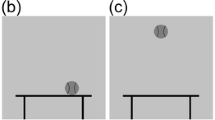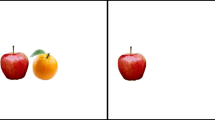Abstract
Projective terms such as left, right, front, back are conceptually interesting due to their flexibility of contextual usage and their central relevance to human spatial cognition. Their default acceptability areas are well known, with prototypical axes representing their most central usage and decreasing acceptability away from the axes. Previous research has shown these axes to be boundaries in certain non-linguistic tasks, indicating an inverse relationship between linguistic and non-linguistic direction concepts under specific circumstances. Given this striking mismatch, our study asks how such inverse non-linguistic concepts are represented in language, as well as how people describe their categorization. Our findings highlight two distinct grouping strategies reminiscent of theories of human categorization: prototype based or boundary based. These lead to different linguistic as well as non-linguistic patterns.
Access this chapter
Tax calculation will be finalised at checkout
Purchases are for personal use only
Preview
Unable to display preview. Download preview PDF.
Similar content being viewed by others
References
Bateman, J., Tenbrink, T., Farrar, S.: The role of conceptual and linguistic ontologies in interpreting spatial discourse. Discourse Processes 44(3), 175–212 (2007)
Bateman, J.A., Hois, J., Ross, R.J., Tenbrink, T.: A linguistic ontology of space for natural language processing. Artif. Intell. 174(14), 1027–1071 (2010)
Bierwisch, M., Schreuder, R.: From concepts to lexical items. Cognition 42, 23–60 (1992)
Carlson, L.A., van der Zee, E. (eds.): Functional features in language and space: Insights from perception, categorization and development. Oxford University Press, Oxford (2005)
Crawford, L.E., Regier, T., Huttenlocher, J.: Linguistic and non-linguistic spatial categorization. Cognition 75(3), 209–235 (2000)
Gapp, K.P.: An empirically validated model for computing spatial relations. In: Wachsmuth, I., Brauer, W., Rollinger, C.-R. (eds.) KI 1995. LNCS, vol. 981, pp. 245–256. Springer, Heidelberg (1995)
Hayward, W.G., Tarr, M.J.: Spatial language and spatial representation. Cognition 55, 39–84 (1995)
Herzog, G.: Coping with static and dynamic spatial relations. In: Amsili, P., Borillo, M., Vieu, L. (eds.) Proc. of TSM 1995, Time, Space, and Movement: Meaning and Knowledge in the Sensible World, pp. 47–59 (1995)
Hickmann, M., Hendriks, H.: Static and dynamic location in French and English. First Language 26(1), 103–135 (2006)
Huttenlocher, J., Hedges, L.V., Duncan, S.: Categories and particulars: Prototype effects in estimating spatial location. Psychological Review 98(3), 352 (1991)
Klippel, A., Montello, D.R.: Linguistic and nonlinguistic turn direction concepts. In: Winter, S., Duckham, M., Kulik, L., Kuipers, B. (eds.) COSIT 2007. LNCS, vol. 4736, pp. 354–372. Springer, Heidelberg (2007)
Klippel, A., Wallgrün, J.O., Yang, J., Mason, J.S., Kim, E.-K., Mark, D.M.: Fundamental cognitive concepts of space (and time): Using cross-linguistic, crowdsourced data to cognitively calibrate modes of overlap. In: Tenbrink, T., Stell, J., Galton, A., Wood, Z. (eds.) COSIT 2013. LNCS, vol. 8116, pp. 377–396. Springer, Heidelberg (2013)
Levinson, S.C., Kita, S., Haun, D.B., Rasch, B.H.: Returning the tables: Language affects spatial reasoning. Cognition 84, 155–188 (2002)
Li, P., Gleitman, L.: Turning the tables: Language and spatial reasoning. Cognition 83, 265–294 (2002)
Logan, G.D., Sadler, D.D.: A computational analysis of the apprehension of spatial relations. In: Bloom, P., Peterson, M., Nadell, L., Garrett, M. (eds.) Language and Space, pp. 493–529. MIT Press (1996)
Medin, D.L., Wattenmaker, W.D., Hampson, S.E.: Family resemblance, conceptual cohesiveness, and category construction. Cognitive Psychology 19(2), 242–279 (1987)
Mervis, C.B., Rosch, E.: Categorization of natural objects. Annual Review of Psychology 32, 89–115 (1981)
Renz, J., Nebel, B.: Qualitative spatial reasoning using constraint calculi. In: Aiello, M., Pratt-Hartmann, I.E., van Benthem, J.F.A.K. (eds.) Handbook of Spatial Logics, pp. 161–215. Springer (2007)
Ross, J., Irani, L., Silberman, M.S., Zaldivar, A., Tomlinson, B.: Who are the crowdworkers? Shifting demographics in mechanical turk. In: CHI EA 2010 Extended Abstracts on Human Factors in Computing Systems, pp. 2863–2872 (2010)
Schober, M.F.: Different kinds of conversational perspective-taking. In: Fussell, S.R., Kreuz, R.J. (eds.) Social and Cognitive Psychological Approaches to Interpersonal Communication. Lawrence Erlbaum, Mahwah (1998)
Smith, E.E., Medin, D.L.: Categories and Concepts. Harvard University Press, Cambridge (1981)
Taylor, J.: Linguistic Categorization. Clarendon, Oxford (1989)
Tenbrink, T.: Space, time, and the use of language: An investigation of relationships. Mouton de Gruyter, Berlin (2007)
Tenbrink, T.: Reference frames of space and time in language. Journal of Pragmatics 43(3), 704–722 (2011)
Tenbrink, T.: Cognitive discourse analysis: Accessing cognitive representations and processes through language data. Language and Cognition (in press)
Vorwerg, C.: Use of reference directions in spatial encoding. In: Freksa, C., Brauer, W., Habel, C., Wender, K.F. (eds.) Spatial Cognition III. LNCS (LNAI), vol. 2685, pp. 321–347. Springer, Heidelberg (2003)
Vorwerg, C., Tenbrink, T.: Discourse factors influencing spatial descriptions in English and German. In: Barkowsky, T., Knauff, M., Ligozat, G., Montello, D.R. (eds.) Spatial Cognition 2007. LNCS (LNAI), vol. 4387, pp. 470–488. Springer, Heidelberg (2007)
Whorf, B.: Language, thought, and reality: Selected writings of Benjamin Lee Whorf. The M.I.T. Press, Cambridge (1956) (Edited by John Carrol)
Zimmer, H.D., Speiser, H.R., Baus, J., Blocher, A., Stopp, E.: The use of locative expressions in dependence of the spatial relation between target and reference object in two-dimensional layouts. In: Freksa, C., Habel, C., Wender, K.F. (eds.) Spatial Cognition 1998. LNCS (LNAI), vol. 1404, pp. 223–240. Springer, Heidelberg (1998)
Zwarts, J.: Vectors across spatial domains: from place to size, orientation, shape, and parts. In: van der Zee, E., Slack, J. (eds.) Representing Direction in Language and Space, pp. 39–68. Oxford University Press, Oxford (2003)
Author information
Authors and Affiliations
Editor information
Editors and Affiliations
Rights and permissions
Copyright information
© 2014 Springer International Publishing Switzerland
About this paper
Cite this paper
Mast, V., Wolter, D., Klippel, A., Wallgrün, J.O., Tenbrink, T. (2014). Boundaries and Prototypes in Categorizing Direction. In: Freksa, C., Nebel, B., Hegarty, M., Barkowsky, T. (eds) Spatial Cognition IX. Spatial Cognition 2014. Lecture Notes in Computer Science(), vol 8684. Springer, Cham. https://doi.org/10.1007/978-3-319-11215-2_7
Download citation
DOI: https://doi.org/10.1007/978-3-319-11215-2_7
Publisher Name: Springer, Cham
Print ISBN: 978-3-319-11214-5
Online ISBN: 978-3-319-11215-2
eBook Packages: Computer ScienceComputer Science (R0)




